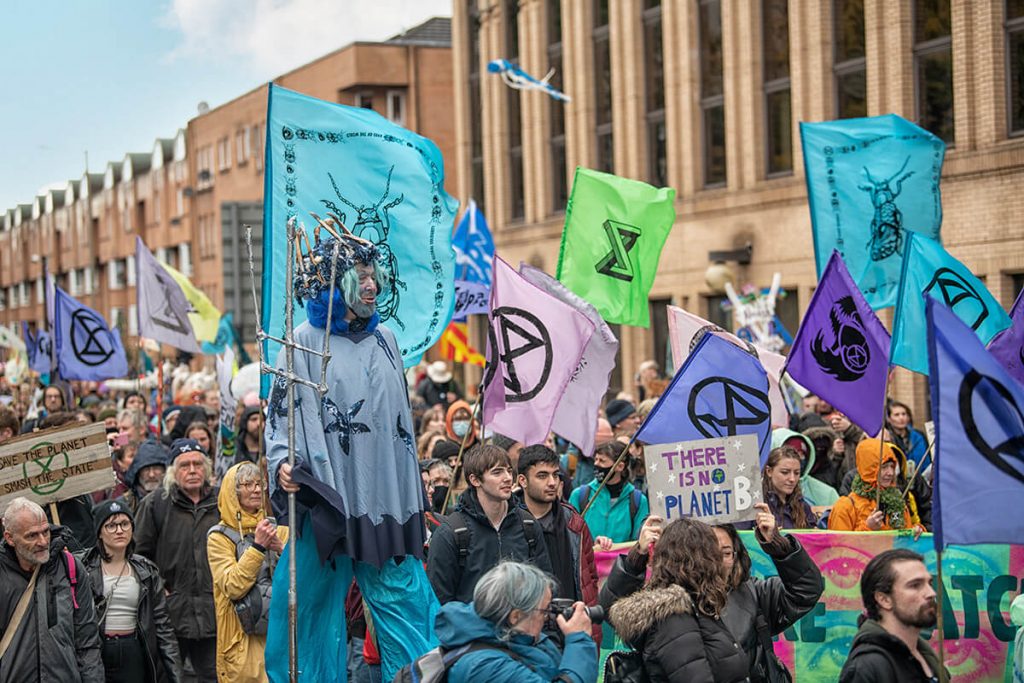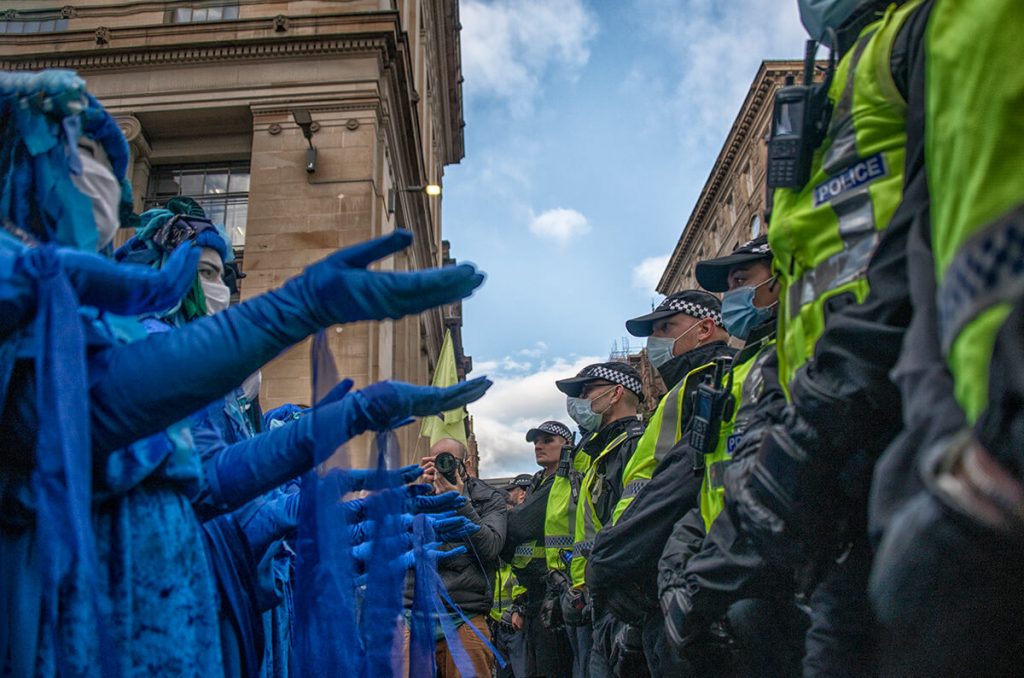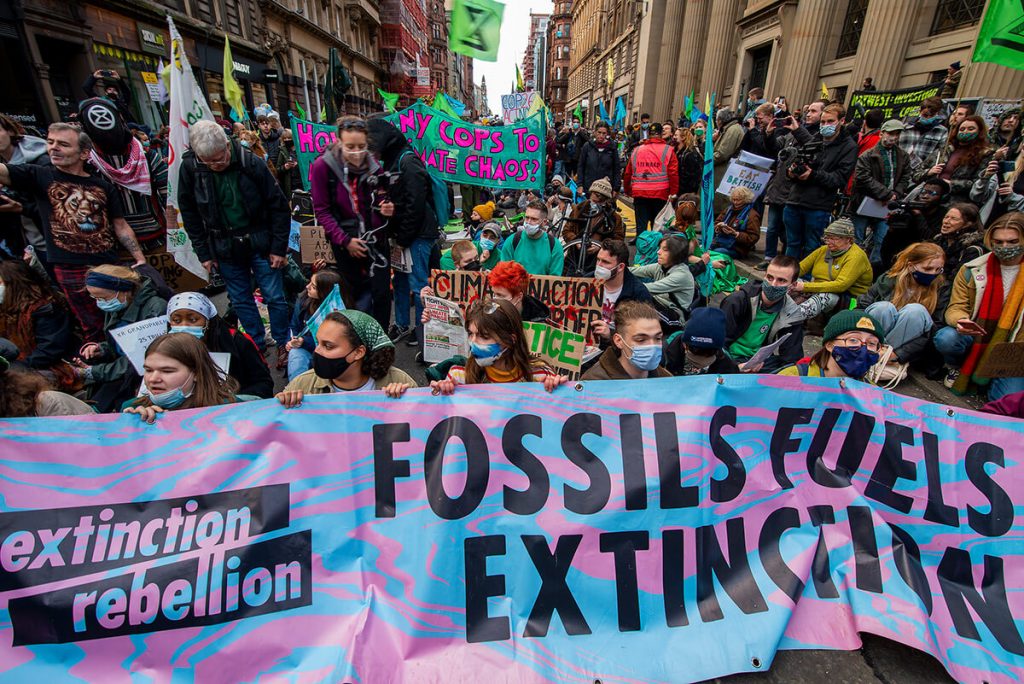Making Change Happen
A 3-pronged XRS strategy for building climate justice
In April 2020, a small group in Edinburgh kicked off XR Scotland’s Strategy Process. Throughout Summer 2020, over 70 people from across the movement met to offer their reflections on some key questions. Focus groups emerged from those reflections, who deliberate and proposed solutions. The following details the finalised strategy, as was agreed to by public meeting in July 2021.

Rationale / What issue does this address?
Our original strategy is based on the assumption that if we put enough pressure on governments through nonviolent direct action (NVDA), they will set up Citizen’s Assemblies, leave them free from interference, and implement their recommendations. Although this strategy has succeeded in raising climate awareness and persuading governments to declare a Climate Emergency, we in Scotland have first hand experience of what actually happens when governments seems to give us what we are asking for. The Scottish Government declared a Climate Emergency, and then issued more licenses to drill in the North Sea; they set up a Citizen’s Climate Assembly, and then made sure the attendees heard what the Government and the civil service wanted them to hear.
So, while NVDA may still produce further results, we propose that it is time to diversify our strategy. Many in XR have already been working with their local communities and with other campaign groups, so our overall proposal is to endorse and encourage this by adding community building and cooperation building strategies to our existing NVDA strategy.
Potential issues:
There is an attachment among some in XR to the idea that we do NVDA and that is all we need to do. See below for possible answers.
#1 Build Community
We build community capacity with the aim of helping to set up Peoples’ Assemblies in as many communities as possible in order to give local people a real voice and create a bottom-up participative democracy that could ultimately replace our current ‘representative’ system.
What issues does this address?
- If indeed governments will lead us a merry dance, giving us the feeling of making progress, while continuing with business as usual, then we must consider adding other options. Prefigurative actions are also in the DNA of XR, and the idea of a more participatory system of decision-making is dear to the hearts of many. By helping local communities across the country to build Peoples’ Assemblies, we can begin to create a more participative, deliberative, democratic system that mitigates for power. Such local assemblies would naturally need to create regional, national and ultimately global assemblies, which would mean that if and when the current system begins to collapse, there would be an alternative decision-making process in place. Note that these assemblies would be self-created by communities, not by XR; we would just provide support.
- NVDA doesn’t suit everyone, so diversity is good. Getting involved in community building might suit those in XR who have good reason to avoid confrontation with police such as Black, Asian and ethnic minorities in big cities or the many people of faith who might see our actions as disrespectful. It might also suit those in more rural areas who could feel that there is nothing for them to do in XR except get arrested in an action in a far away city.
Potential issues:
- This will require work and collaboration to achieve! It could be a drain on already stretched capacity, however, it actually aims to increase capacity by broadening ways to get involved.
- Due to negative perceptions of XR’s tactics at the moment, XR groups or individuals who engage with local communities to establish Peoples Assemblies might decide to work simply as local community members and only mention XR when necessary and/or useful.
Examples:
- An XRS Dundee member gave a talk on People’s Assemblies which indirectly inspired the establishment of a local People’s Assembly. XR did not set it up – it was the result of collaboration between various organisations and individuals including some from XR and also some enthusiastic council community workers. It’s a great example of what collaboration can achieve, and of how the first two prongs of this proposed strategy can complement each other.
- Another possibility is to get rebels elected to Community Councils (CC) and then use that as a vehicle to set up People’s Assemblies. The rationale for this is that the model constitution for a CC says it should “reflect the views of the community it represents”, “take such action in the interests of the community as appears to it to be desirable and practicable” and finally “be a means whereby the people of the area shall be able to voice their opinions on any matter affecting their lives, their welfare, their environment, its development and amenity.” However, there is a valid perception that in practice CCs do not achieve anything of significance, and this may affect support for this strategy. Nevertheless, it is our belief that this weakness can be a strength, as many CC seats are uncontested at CC elections. And when local authorities try to tell us that we can’t do X, Y or Z, we remind them of our name and that we stand in rebellion.

#2 Build Collaboration
We build collaboration by working closely with communities and groups who share some of our aims, to create a broad alliance which highlights and addresses harm from the Climate and Ecological Emergency and systemic injustice.
What issue does this address?
- The focus group recognised a need for XR to collaborate more with other groups. Based on previous interactions with other movements, there is a perception from some that XR seems to be saying to the world that we have all the answers and that everything would be fine if everyone just joined XR. People who have been activists for decades can find this puts them off working with us. As the new kid on the block XR had to establish our identity and what we stand for. We have done that and created our own space, and we now need to have the confidence in ourselves to reach out to others, to offer support and collaboration on issues of mutual concern.
- We also recognised a need to increase our relevance to communities who have first-hand experience of issues and impacts in their area. Working in a more detached way, we may have missed opportunities to build collective understanding and credibility within the communities most affected by systemic injustice and harm from CEE.
- A more collaborative approach can address issues of capacity, as we build collective power.
- We can strengthen impact and media attention by amplifying a collective message.
Potential issues:
Which groups are suitable and how can we help them? We need to avoid being prescriptive as there is no one way to approach collaboration. One of XR’s great strengths is the autonomy of individuals and groups; each person and group will find their own way. We have some wonderfully talented people within XR, and lots of resources that could help others, so we need to find other groups who share our values, and offer collaboration and support that they need, and who knows we might just build something amazing.
Example:
Following an action at INEOS in Grangemouth, XRS is aiming first to conduct outreach and consultation with locals on lived experience and issues in the area, looking beyond just climate/pollution to meet the community where they’re at and aiming to draw the lines between systemic injustices. Then, if we receive positive engagement, we will aim to build collective power with the community potentially through a range of tactics such as digital storytelling, helping facilitate grassroots participatory democracy processes, mutual aid and prefigurative action. We will be learning and responding as we go.

#3 Build Pressure
We build pressure through nonviolent direct actions targeted at, and highlighting connections between, governments, the fossil fuel industry, financiers, media and other drivers of the toxic system.
What issue does this address?
For 40 years, gradualist strategies have been tried, such as working through NGOs, politicians and the courts, but they didn’t work: we are still drilling for oil and gas, still burning it ourselves or selling it overseas for others to burn, and still planning new coal mines and airport expansions. Therefore, XR was set up to take nonviolent direct action (NVDA), which has been shown many times by movements such as the Suffragettes and the Civil Rights movement to be a highly effective way to achieve social change. NVDA is in the DNA of our movement. The opportunity to take nonviolent direct action together is the main reason why so many mobilised to join us: it is a chance to take direct action against the direct threat to our survival as a society and a biosphere. It raises public awareness and builds momentum for change. In addition, civil resistance theory predicts that if enough people mobilise to take coordinated direct action such as blocking the centre of the capital city, the police will not be able to cope with the thousands of arrests, and the government may be forced to truly negotiate, which in the case of the Climate and Ecological Emergency, would mean setting up a Climate Citizens Assembly with real power to guide us through the transformative changes that we need.
Potential issues:
- Evidence for XR NVDA strategy, eg from Chenoweth and Stephan (2011), has been questioned, especially the claim that mobilisation of 3.5% of the population guarantees movement success
- There are doubts that our political system would ever fully implement a Citizens Assembly and honour its recommendations
- An arrest focus excludes many, especially poorer people and Black, Asian and minority communities
- Currently not enough to do for (new) members, especially in rural areas
- We’ve tried it twice and it hasn’t worked yet
- XR’s blockades of city centres seem to be very unpopular and this could negatively impact on attempts by XR groups to Build Community through local Peoples Assemblies
Some answers:
- NVDA is in our DNA! It’s radical action to match a desperate situation. It’s why most folk joined XR.
- Our NVDA attracts media attention. This can be used to raise awareness of our work to build collaboration and community.
- The evidence base may be flawed in some ways and 3.5% is just one estimate, but the theory and practice of NVDA still have great relevance. So let’s not throw the baby out with the bath water. Escalating mass NVDA at least gives us a small chance of rapidly achieving our aims, compared with conventional means such as marching and signing petitions.
- Not all XR actions have to have an arrest focus. Also, there are many vital roles within XR that do not involve risk of arrest.
- To some extent, it is inevitable that a radical flank organisation like XR goes through periods of unpopularity, as it pushes the window of what is politically possible.
Possible ways to make our NVDA more effective:
- We should disrupt the powerful, not the powerless: eg be selective when blocking city centres by targeting gov and fossil fuel offices rather than public transport
- Focus on weakening pillars of Govt support eg build cooperation with oil and gas workers (who are key workers in the current economy) so that they see that their longer term interests align with ours rather than the Govt’s, leading to joint disruptive action to demand an immediate just transition
- We should use a wider range of NVDA eg slow downs, boycotts, tax refusal etc. See 198 Methods of Nonviolent Action – Albert Einstein Institution
- We can learn from our experience of NVDA so far, and continue with recent actions which have achieved some success, eg targeted actions aimed at banks or media, and connected actions occurring simultaneously or in ‘waves’ across the country or the world, such as Money Rebellion
- One purpose of our actions should be to build community and cooperation eg actions as part of local community campaigns
Examples:
XRS ‘Make the Connections’ NVDA campaign over Summer 2020 and the International Rebellion in April 2019
All of this should be underpinned by listening to and learning from others, as well as sharing awareness about a sustainable future and how to get there.
Join new working groups
XR Scotland are starting three new working groups. If you would like to join one of these groups, please make yourself known in the corresponding Mattermost channel:
 Healthy Ways of Being
Healthy Ways of Being
Join the Healthy Ways of Being group
 Accessible Languages
Accessible Languages
Join the Accessibility Languages group
 Justice, Solidarity, and Anti-Oppresion
Justice, Solidarity, and Anti-Oppresion
Join the Justice, Solidarity and Anti-Oppression group
If you have not yet joined Mattermost, please contact xrscotlandtech@protonmail.com
